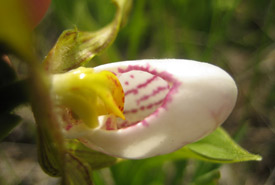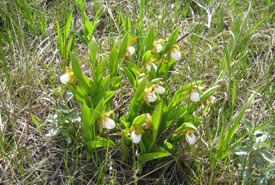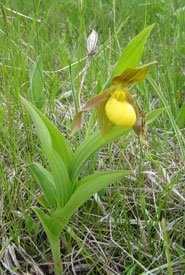Pollination deception: Manitoba’s lady’s slipper orchids

Small white lady's-slipper (Photo by Melissa Grantham)
In Manitoba we have several species of lady’s slipper orchids, but the two I am most interested in, and have researched, are the yellow lady’s slipper (Cypripedium parviflorum) and the provincially endangered small white lady’s slipper (C. candidum). One of the things that make them so interesting to me is that they have a very particular way of interacting with their pollinators.
For many flowering plants, the process of pollination is fairly simple: produce a reward (e.g. nectar, pollen and edible oils) that pollinators desire to keep them coming back to take care of business. Lady’s slipper orchids on the other hand, are very wily; they don’t produce a reward at all, but still manage to receive pollination services. Instead, their flowers falsely advertise the presence of these rewards to trick pollinators into paying them a visit.
This deception is a very risky business, because reproductive success for the plants depends on how good the deception is, and how long the plant can continue to attract the pollinators before they learn to avoid these plants that offer them no reward.
The orchid family contains thousands of species and the largest number of plants with this deceptive pollination system.

A cluster of small white lady's-slipper (Photo by Melissa Grantham)
One of the additional complications for the lady’s slippers is that the size of insect visitors and the size of certain floral parts can affect whether or not pollination is successful. It all has to do with the flower’s design, and the shape and size of certain parts.
This is how it works: the orchid's petals form a hollow slipper shape. This slipper acts as a one-way temporary trap, and once insects have entered the flower they can’t exit the same way due to the rolled over edges and smooth interior surface of the slipper. Their only choice is to move forward!
Insects are guided towards a narrow passage by colourful markings, hairs and translucent windows on the slipper. They must then move through this passage and out of the slipper through the exit routes, which consist of constricted openings near the reproductive organs. This configuration leads insects past the stigma and then the anthers.
Now here’s the rub: If the pollinator has the right general size and shape, this may result in the transfer of pollen on to the body of the pollinator, who can then go on to pollinate another orchid. But, if an insect is too large or too small, it either can’t get out, or gets out without contacting the pollen – which means no pollination in either case.

Yellow lady's slipper (Photo by Melissa Grantham)
Another interesting tidbit: by comparison, yellow lady’s slippers produce more fruit than the small white lady’s slippers do. This is partly because of the larger flowers on the yellow lady's slipper, as well as its larger pollinator entry and exit routes. This allows the yellow lady's slippers to accommodate a much larger number and variety of pollinators than the small whites do.
I feel very fortunate to have had the opportunity to learn so much about these amazing plants and their pollinators. Understanding pollination processes and interactions is a very important consideration for conservation issues surrounding threatened or endangered species, such as the small white lady’s slipper.


